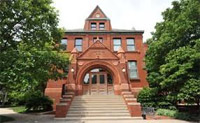Architecture, College of

Masters in Architecture Program: Theses
First Advisor
Jeffrey L. Day
Date of this Version
Spring 5-3-2021
Document Type
Thesis
Citation
(CMS Bibliography Entry)
Cox, William E. "White Noise Dark Ecology: Designing For The Soundscape." M.Arch. thesis, University of Nebraska, 2021.
Abstract
This thesis explores the intersection of architecture, sound, and ecology. It works through the methodology on how to modulate and produce soundscapes rich with various sound objects. It addresses questions on how designers can use the act of listening to engage with the soundscape. This exploration hopes to continue to find niches which create opportunities for new interactions between architecture and ecology through sound. This is all in a continued effort to engage in positive feedback loops between architecture and non-humans to actively break down the divide between the artificial and natural through sound and architecture by designing for the soundscape.
To do so, one must listen.
Listening offers a novel method of designing. When one considers the soundscape, the scope of design immediately expands to aural and ecological needs. These designs become ones that extend past our plenum of experience to promote architecture which uses human agency to create non-human agency. Historically, the interaction of architecture with both sound and ecology has been through abating, mitigating, and ameliorating, to the point where our intersection with these systems only serves the ideal of each, or a gross misrepresentation of the actual and a rather anthropomorphized ideal at that.
This thesis works towards an architecture which is based around the ecological praxis of a sound oriented ontology. It is one that uses the designer as curator of conditions, filtering the sonic landscape to create conditions which create opportunities for authorship by non-humans, the result becomes an emergent architecture rather than static.
Advisor: Jeffrey L. Day
epub


Comments
A design thesis Presented to the Faculty of The College of Architecture at the University of Nebraska In Partial Fulfillment of Requirements For the Degree of Master of Architecture, Major: Architecture, Under the Supervision of Professor: Jeffrey L. Day. Lincoln, NE, May 2021
Copyright 2020 William E. Cox